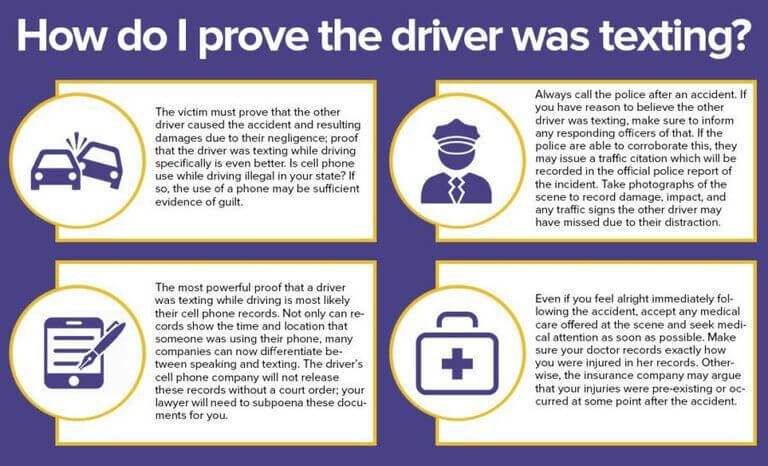The dangers of driving while intoxicated are well-publicized, but a new form of distracted driving could be even more deadly: texting and driving. The National Highway Traffic Safety Administration (NHTSA) found that texting while driving is more dangerous than driving with a blood-alcohol level of .08, which is considered legally intoxicated it almost every state.
In fact, a collision is 23 times more likely to happen if the driver is texting. The likelihood of being hit by a driver who is texting gets greater every year, and 30% of car accidents are caused by drivers who admit to texting right before the accident. But what about the drivers who will not admit it? In the unfortunate event that you are involved in a collision with a distracted driver, how do you prove that the other driver was texting and driving?
Is the driver who was texting liable?
Yes. In all 50 states, every driver has the legal obligation to look out for the well-being and safety of every other driver on the road. Intentionally engaging in an activity known to be dangerous, like texting and driving, is negligent conduct.
That is, that driver has failed in their obligation to look out for the safety of other drivers. When a car accident is caused by that driver’s negligence, the driver is legally responsible for the damage done to the victim. The courts have traditionally ruled that a driver who is texting and driving is negligent. As the victim of that driver’s negligence, you are entitled to retrieve compensation for all reasonable damages directly related to the accident.
What is distracted driving?
Distracted driving is when a driver is distracted at any time which diverts their attention from the road to any other task. While most individuals immediately think of texting and driving there are numerous other types:
- Applying makeup while driving
- Eating while driving
- Disciplining children while driving
- Talking on the phone while driving
- Texting or even sexting while driving
- Checking social media
How is electronic distracted driving different?
The greatest cause of distracted driving today is undoubtedly cell phones. Using a cell phone or any other piece of technology while operating a vehicle is referred to as electronic distracted driving. Even using a phone’s GPS function is considered to be electronic distracted driving.
Consider, individuals that may pull up their laptop to send out that last-minute email or to review files for work, all of these devices are able to distract us from driving.
Why are distracted driving laws so ambiguous?
Distracted driving is still a relatively new threat to our roadways, ever-changing technology also makes it difficult for our state legislature to pass effective bills that help protect us, while not encroaching on the freedoms that we hold so dearly.
What damages are “reasonable”?
Reasonable damages in the case of a negligent driver primarily include physical damage to property, bills, and any out-of-pocket expenses directly related to the accident. Repairs to the car’s engine, compensation for personal property damaged in the accident, physical therapy, rental car costs, and crutches are all considered reasonable damages.
Intangible costs like mental anguish and emotional distress can also be considered reasonable damages. Unreasonable damages might include the emotional distress of a family member, speculative future earnings, and other costs that cannot be reasonably tied directly to the accident.
How do I prove the driver was texting?

It does not matter if the negligent driver is liable if you do not have evidence that their negligence was the cause of the accident. The victim must prove that the other driver caused the accident and resulting damages due to their negligence; proof that the driver was texting while driving specifically is even better.
Is cell phone use while driving illegal in your state? If so, the use of a phone may be sufficient evidence of guilt. Always call the police after an accident. If you have reason to believe the other driver was texting, make sure to inform any responding officers of that. If the police are able to corroborate this, they may issue a traffic citation which will be recorded in the official police report of the incident. Take photographs of the scene to record damage, impact, and any traffic signs the other driver may have missed due to their distraction. The most powerful proof that a driver was texting while driving is most likely their cell phone records. Not only can records show the time and location that someone was using their phone, but many companies can also now differentiate between speaking and texting. The driver’s cell phone company will not release these records without a court order; your lawyer will need to subpoena these documents for you.
Even if you feel alright immediately following the accident, accept any medical care offered at the scene and seek medical attention as soon as possible. Putting off treatment will make it more difficult to prove that any injuries you have sustained were the direct result of the accident. Make sure your doctor records exactly how you were injured in her records. Otherwise, the insurance company may argue that your injuries were pre-existing or occurred at some point after the accident.
Why does the legality of cell phone use while driving differ from state to state?
There are no Federal Laws regulating cell phone use while driving, so it falls to the states to decide whether they believe driving while using a cell phone should be illegal. Georgia law clearly states that under no circumstances should any driver be texting while driving. The recommendation of our firm is to not use your phone at all while working to navigate to your destination.
Which states ban the use of cell phones for every driver?
No states have banned all cell phone use for every driver. Many states may require a driver to have a certain amount of experience before allowing them to use their cell phone while operating their car. Other states may require drivers to use the hands-free function of their phones while driving. However, almost every state has banned texting while driving.
Do I need an attorney?
Injury claims can be very difficult, and an experienced attorney has the resources to do extensive pretrial discovery and will work to secure the highest settlement possible for you. If your injuries are minor, like sprained muscles, you may be able to handle y our own claim without issue.
But if you have suffered more serious injuries or the at-fault driver’s insurance company will not accept liability, the aid of an experienced car accident attorney will be invaluable in making sure you receive the damages you deserve. View the entire infographic here.
How To Stop Texting And Driving
It should come as no surprise that many companies are looking for any way they can try to stop texting and driving. The National Highway Traffic Safety Administration believes that as many as eight people die every day in car crashes that occurred as a result of texting and driving. Many states have made texting and driving illegal, but the general population is apathetic.
Sadly, one of the most common groups of people who text and drive are young adults and teenagers. Nearly all teenagers will say they know that texting while driving is hazardous, but many still admit to doing it. That alone makes it seem that merely educating people will not be enough to stop texting and driving. That is likely the reason responsible businesses are taking matters into their own hands by attempting to cut out texting while driving.
Phone Updates and Distracted Driving
Apple, the creators of iPhones, have begun to combat texting and driving and, perhaps, may end the habit for good. Apple has released its newest operating system: iOS 11. The new iOS will have a feature called “Do Not Disturb While Driving.” The new feature will put the iPhone in a state where it is unable to receive incoming calls or texts while connected to a moving car with Bluetooth or a cable.
The phone withholds all incoming calls and texts until the vehicle comes to a stop. If you receive an incoming call or text while in a moving vehicle, the new feature may respond to who sent the call or text to inform them you are driving and are not able to answer for the moment.
The function will also cause the phone’s screen not to work while the car is moving to prevent drivers from using their apps while driving. If someone in the passenger seat wants to use the phone, they will disable the feature once they can prove that they are not driving. Some driving-based apps will work while the new feature is active.
Technology to Prevent Distracted Driving
Apps that are made specifically for road usage, like Apple Maps, will still be usable, although they will have restricted access. The driver can see the map on the screen, but they cannot input or change their desired destination. Other navigation apps, will also work on the new feature, although they will be more difficult to set up.
Apple CarPlay will also be available in cars that the technology to use it. Apple CarPlay is an interface system that allows drivers to hear and respond to a text with their voice. A driver will not have to take his or her eyes off the road to reply, so the speech-to-text software allows them to reply safely. Cars that are equipped with Apple CarPlay have a screen in the car to control the system.
The screen is often easy to see, so the driver may look at it to find the input he or she wants, and then they can immediately return their concentration to driving. Many automobile manufacturers create vehicles that come equipped with Apple CarPlay technology. A few of the manufacturers are:
- BMW
- Honda
- Fiat Chrysler
- General Motors
Drivers consistently ignore technology like Apple CarPlay and continue to text and drive despite being given the tools to do so safely. Making their phones uncooperative is a great way to ensure that drivers are safe by forcing them to use technology to make everyone safer on the roadways.
Other ideas from responsible companies
Several companies are making an effort to solve the epidemic of texting and driving. For example, Nissan may begin equipping its cars with Faraday cages. A Faraday cage is a box that blocks electricity and radio waves. Placing one in a car would stop cell phone reception in the car, so the driver would not be able to send or receive messages, or even to make calls.
In short:
- Always call the police after an accident.
- Report to the police that you believe they were using their cellphone.
- Take pictures of the damage as well as traffic signs the other driver may have missed.
- Receive any medical car offered- even if you feel okay at the moment.
- Hire an attorney so they can subpoena the driver’s phone records.

